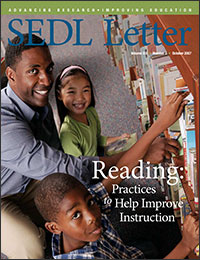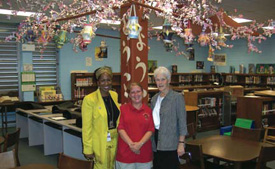Banneker Elementary School: On Course with Reading
It is a slightly overcast spring day in New Orleans. The 20 students in Jan Abraham’s second-grade class at Benjamin Banneker Elementary School start off the day singing a song and signing the lyrics. Two of the students in the class are deaf, which isn’t surprising since Banneker is a full-inclusion school.
At nearby Dr. Charles Drew Elementary School, Regis Philbin and Kelly Ripa are taping the unveiling of the school’s new playground, funded by Disney-ABC Domestic Television and KaBOOM!, for their show, “Live with Regis and Kelly.” Down the street from Banneker, a movie is being filmed. Adults conversing in a hallway at Banneker talk about the visiting celebrities and how “New Orleans is coming back.” Nowhere is this revival more important than in the schools of New Orleans, including Banneker.
Banneker is by all accounts one of the best schools in the Recovery School District (RSD), which operates 39 schools and oversees 27 charter schools in New Orleans. The atmosphere at the school is calm and organized. The principal, Cheryllyn Branche, and assistant principal, Sister Marie Noelle, were at Banneker before Hurricane Katrina. They stayed with the school throughout the resultant difficult months, providing support and guidance. All but one of the 17 regular teachers are certified, and not one teacher left the school during the 2006-2007 school year. These are undeniable accomplishments in a district challenged by personnel turnover.
Despite having good administrators and dedicated teachers, Banneker remains low performing. Generally, only one or two students in each class have met literacy benchmarks. Part of the problem lies with student mobility and the large number of students who returned during the school year. At the beginning of the school year, each class had only 15–18 students. By May, some classes had as many as 30 students.
“It’s a challenge throughout the RSD,” says Banneker curriculum coordinator Marianne Lemle.
Reading stories out loud is part of the “Text Talk” sequence that Jan Abraham uses in her classroom.
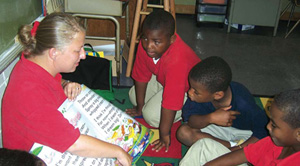
Recovery School District in New Orleans | |
| Most of the schools in New Orleans are in the state-run Recovery School District (RSD). The RSD was established in 2003, before Hurricane Katrina hit, to turn underperforming schools into successful schools. When the hurricane struck 2 years later, the state legislature voted to put 107 of 128 New Orleans public schools in the RSD. Twenty-two New Orleans schools opened in that district during the 2006–2007 school year, not including charter schools. Seventeen more opened in Fall 2007. Most of the schools are preK–8 schools, a decision made pre-Katrina. Many parents and teachers have expressed concerns regarding discipline problems they associate with the large grade span, but lack of buildings and teachers following the storm have factored into the decision to keep the preK–8 structure. | 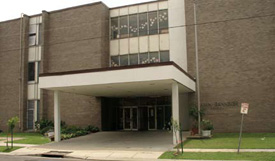 |
|
Principal Cheryllyn Branche, teacher Jan Abraham, and assistant principal Sister Marie Noelle pose in the colorful library at Banneker Elementary. | |
She notes that some of the returning students have not been in school for 6 months or even a year. “It’s not their fault,” Lemle emphasizes.
According to Lemle, another factor contributing to low achievement is that most students lack a good foundation in reading. Former RSD superintendent Robin Jarvis (now program manager of SEDL’s Southeast Comprehensive Center) agrees with Lemle’s assessment. Jarvis notes that the district’s test data show below-level achievement at all grade levels. “The students did not get a good foundation in reading,” she says. “So we must begin at K–3 and address the foundation. Low achievement shows up in fluency and comprehension assessment in later grades but is attributable to foundation skills.”
SEDL reading staff conducted three literacy trainings for all of the teachers in the RSD during the past year. The trainings, customized for teachers in grades K–4 and 5–12, focused on theories of learning to read and research-based practices. The training sessions for the K–4 teachers focused on phonological awareness, the articulation of speech sounds, components of an effective phonics lesson, and strategies for building fluency, vocabulary, and comprehension. The sessions for teachers in grades 5–12 focused on 15 elements of effective adolescent literacy programs, reading and writing in the content areas, processing systems that support reading, and research-based practices for improving fluency, vocabulary, and comprehension.
Jill Slack, a project director with SEDL’s Southeast Comprehensive Center, says, “We worked closely with state staff to tie the training sessions to essential components of the Louisiana Literacy Plan and Reading First model, which in turn tie to the state standards. All teachers—reading, content area, and even those who teach electives such as art and music—learned and practiced a repertoire of research-based strategies to help their students become more competent readers.”
Improving Vocabulary Instruction
“Text talk” is an approach to vocabulary instruction developed by Drs. Isabel Beck and Margaret McKeown (Beck & McKeown, 2001; Beck, McKeown, & Kucan, 2002; McKeown & Beck, 2003) that focuses on teaching words from stories and poems read aloud to students. It takes advantage of young readers’ listening and speaking competencies to boost vocabulary development. Just reading aloud isn’t enough to improve vocabulary, but teacher-student discussion about the story, book, or poem can improve both comprehension and vocabulary. Teachers can help students understand what new words mean by providing student-friendly definitions, discussing the word in the context of the story, and relating the word to situations with which students are familiar. Teachers can also ask open questions that allow students to make connections among ideas presented in the reading and conduct activities that enrich student understanding—in other words, provide opportunities for children to reflect on what is happening in the story or with the language.
Beck and McKeown (2001) noted that teachers also should encourage children to use the words after the initial discussion: “If children do not think about and use a word after initial instruction it is unlikely to become part of the vocabulary repertoire” (p. 18).
An example of a text talk lesson that focuses on vocabulary is shown below.
Sample Text Talk Instructional Sequence
- Read aloud the story Charlotte’s Web by E. B. White.
- Contextualize the word within the story
- In the story, Wilbur was enthusiastic about making new friends.
- Provide a student-friendly explanation of the word.
- Enthusiastic means you are happy or excited about something.
- Have children say the word.
- Say the word with me, enthusiastic.
- Present examples of the word used in contexts different from the story context.
- Someone might be enthusiastic about seeing a new movie, or someone might be enthusiastic about going to Disney World.
- Engage children in activities that get them to interact with the word.
- Share something you would be enthusiastic about. Try to use the word enthusiastic when you talk about it. You could start by saying something like “I would be enthusiastic about ___________________________.”
You could then say to a student, “Show us how you might act if you felt enthusiastic about _____________________________.”
You could ask students: Would you be enthusiasticif- You could get a puppy?
- You had to go to the doctor for a shot?
- Your best friend was coming over to play?
- Share something you would be enthusiastic about. Try to use the word enthusiastic when you talk about it. You could start by saying something like “I would be enthusiastic about ___________________________.”
- Have children say the word again.
- What’s the word we’ve been talking about?
Based on the work of Isabel L. Beck, Margaret G. McKeown, and Linda Cucan, Bringing Words to Life. Used with permission from Guilford Press.
Back in Jan Abraham’s classroom at Banneker Elementary, visitors can see the results of the literacy training. With Abraham’s guidance, the students discuss a book they recently read called Cool Ali and then compare it with a poem called Summer Shower that Abraham reads aloud. This gives the class the opportunity to discuss the weather and metaphors and to recall the plot and characters in Cool Ali. They also work on spelling, finish a syllable-sorting activity, study their vocabulary words, and talk about compound words. Abraham uses an approach to teach vocabulary called “text talk” (see the sidebar, “Improving Vocabulary Instruction”) where she emphasizes certain vocabulary words in the story and poem that may be unfamiliar to most of her students. Today’s words include “admired,” “fussed,” and “mimicked.” She provides a student-friendly explanation for each word, uses it in the context of the story, presents other contexts, and provides opportunities and activities for the students to use the word.
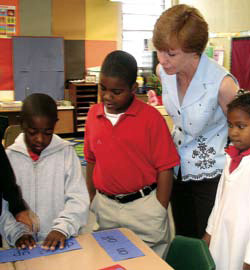
Former Recovery School District superintendent Robin Jarvis helps play a vocabulary game in Jan Abraham’s second-grade classroom.
The students’ enthusiasm makes it difficult to believe they are low achievers in reading. They do so well on one of the vocabulary tasks that Abraham encourages them to “kiss” their brains, which results in a flurry of students kissing their fingertips, then touching the top of their heads.
Ginger Grant, a distinguished educator with the Louisiana Department of Education who works with schools in the RSD, notes that “the SEDL strategies were very teacher friendly—you can utilize them with any program.” She adds, “Teachers don’t have any reason to say they can’t implement these strategies.”
Kathleen Wagner, the reading intervention teacher at Banneker, agrees. She says the reading strategies can be implemented across the curriculum, too. “A lot of techniques teachers don’t think they can use with the upper grades. That’s not true,” she says. “We forget we’re still dealing with children. We can’t presuppose they won’t accept it. Vocabulary has been our weakest link. Now we’re able to zero in on it.”
The training covered the key ingredients of effective reading instruction substantiated by research, which also are reflected in the district’s reading programs.
Teachers gained the knowledge to select the most relevant or critical instructional activities from the material offered by the core reading programs, depending on the needs of their students.
Wagner says the students at Banneker are clearly making progress. She produces a series of DIBELS reports and graphs for each K–3 class. The graphs show how much progress has been made since the first of the school year. By their lack of certain data, the graphs also show the number of students who have left the school or come to the school during the year.
"We don’t have a lot of children at benchmark, but they truly have advanced," she reports enthusiastically.
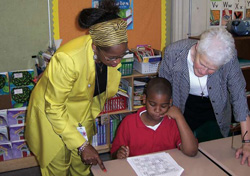
Banneker principal Cheryllyn Branche and assistant principal Sister Marie Noelle are always willing to check a student’s work.
Banneker helps teachers analyze student data. They rely on results from Louisiana’s standardized achievement tests, iLEAP and LEAP, for grades 4–5 and the Scholastic Reading Inventory for grades 6–8. Because the school opened in April 2006 with a new staff and new students, virtually everyone began 2006–2007 at ground zero data-wise. "Teachers now know who is at benchmark and who is close. Next year we will know where we’re headed," Wagner says.
Wagner is a veteran reading teacher, but she is the only interventionist for the entire school of 460 students. Banneker has only eight ESL students but a large population of students with special needs. Fortunately, the special education staff increased during the school year. College students from the Tulane Reading Buddies program also help out at the school. The student tutors received training about working with the children and coordinated with teachers to make sure Reading Buddies books and stories were the same as or were similar to stories being used in the classroom.
Wagner reports that the preK–2 teachers meet as group fairly often and grade-level planning is encouraged. For most of the school year, 1 hour a day was set aside for embedded professional development where staff could plan lessons and share strategies and lesson plans. "People have stayed the course," Wagner says. "They are committed. We’ve built a team."
References and Suggested Readings
- Beck, I. L., & McKeown, M. G. (2001). Text talk: Capturing the benefits of read-aloud experiences for young children. The Reading Teacher, 55(1), 16–20.
- Beck, I. L., McKeown, M. G., & Kucan, L. (2002). Bringing words to life: Robust vocabulary instruction. New York: The Guilford Press.
- Lehr, F., Osborn, J., & Hiebert, E. H. (2004). A focus on vocabulary. Honolulu, HI: Pacific Resources for Education and Learning.
- McKeown, M. G., & Beck, I. L. (2003). Taking advantage of read-alouds to help children make sense of decontextualized language. In A. van Kleeck, S. Stahl, & E. Bauer (Eds.), On reading books to children (pp. 159–176). Mahwah, NJ: Erlbaum.
Next Article: SEDL National Art Contest
